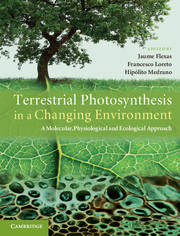 Terrestrial Photosynthesis in a Changing Environment
Terrestrial Photosynthesis in a Changing Environment Book contents
- Frontmatter
- Contents
- List of contributors
- Preface
- Acknowledgements
- List of abbreviations
- 1 Terrestrial photosynthesis in a changing environment
- Part I Photosynthesis
- 2 Biochemistry and photochemistry of terrestrial photosynthesis: a synopsis
- 3 Photosynthetic regulation
- 4 Interactions between photosynthesis and day respiration
- 5 The ecophysiology and global biology of C4 photosynthesis
- 6 Ecophysiology of CAM photosynthesis
- 7 Special photosynthetic adaptations
- 8 Models of photosynthesis
- Part II Measuring photosynthesis
- Part III Photosynthetic response to single environmental factors
- Part IV Photosynthesis in time
- Part V Photosynthesis in space
- Part VI Photosynthesis in a global context
- References
- Index
7 - Special photosynthetic adaptations
Published online by Cambridge University Press: 05 March 2013
- Frontmatter
- Contents
- List of contributors
- Preface
- Acknowledgements
- List of abbreviations
- 1 Terrestrial photosynthesis in a changing environment
- Part I Photosynthesis
- 2 Biochemistry and photochemistry of terrestrial photosynthesis: a synopsis
- 3 Photosynthetic regulation
- 4 Interactions between photosynthesis and day respiration
- 5 The ecophysiology and global biology of C4 photosynthesis
- 6 Ecophysiology of CAM photosynthesis
- 7 Special photosynthetic adaptations
- 8 Models of photosynthesis
- Part II Measuring photosynthesis
- Part III Photosynthetic response to single environmental factors
- Part IV Photosynthesis in time
- Part V Photosynthesis in space
- Part VI Photosynthesis in a global context
- References
- Index
Summary
Introduction
Photosynthesis studies and models are usually restricted to green leaves. However, a closer observation of nature reveals that most plants also photosynthesise through non-foliar structures, and photosynthetic tissues are not always green. Non-foliar photosynthesis is performed by a variety of organs such as stems, bark, roots, petioles, fruits or flowers. These structures contribute positively to the carbon balance, and in some leafless species these are the only photosynthetic organs. In general, two main groups of photosynthetically active organs can be discerned (Aschan and Pfanz, 2003): those optimised for photosynthetic performance that achieve a net positive carbon gain (such as green petals, leaves or stems); and those involved in the internal recycling of CO2 released by respiration (such as roots, fruits or chlorophyll-containing bark) (Table 7.1). With a few exceptions, chlorophyll is the only green pigment in plants, implying that all green tissues are chlorophyllous, and all chlorophyll-containing organs are, to some extent, photosynthetic. Nevertheless, photosynthetic organs may not appear green externally because of chlorophyll being masked by outer layers of pigmented cells, waxy cuticles or bark. In addition to plants with whole leaves or parts of leaves (variegated leaves) presenting special photosynthetic characteristics, unique photosynthetic adaptations are also shown by parasitic and submerged plants. Also, stomatal cells from typical leaves of higher plants display specific photosynthetic features, different from those of mesophyll cells.
- Type
- Chapter
- Information
- Terrestrial Photosynthesis in a Changing EnvironmentA Molecular, Physiological, and Ecological Approach, pp. 85 - 97Publisher: Cambridge University PressPrint publication year: 2012
- 2
- Cited by
